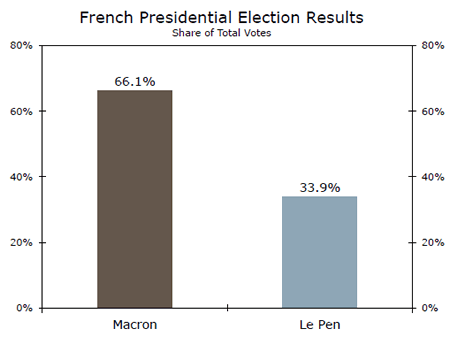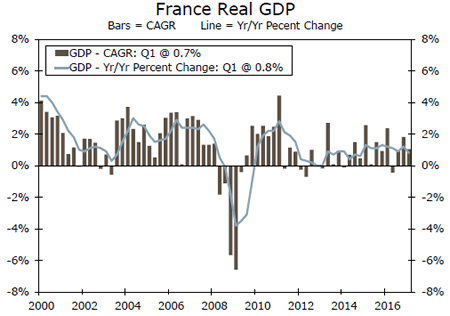U.S. Review
Mixed Signals on Inflation to Start Q2
- Survey data from businesses suggest that the labor market continues to tighten.
- Import and producer prices showed signs of acceleration this week, but another soft reading for the core CPI sends mixed signals to the Fed. On balance, the Fed remains positioned to hike rates in June while maintaining its slow and steady mentality.
- Retail sales were disappointing in April, but upward revisions to March’s initial reading may indicate personal consumption growth was likely a bit stronger in Q1 than initially reported.
Mixed Signals on Inflation to Start Q2
The National Federation of Independent Business (NFIB) Small Business Optimism Index kicked off the week with a small decline of 0.2 points in April. The decline was led by a drop in expectations for improvement in the economy, which fell 8 points following the initial unsuccessful attempt to replace the Affordable Care Act. Despite the dip, confidence remains high, and the employment segments of the survey signaled even more pronounced labor market tightening. The share of respondents saying that it is hard to fill job openings edged up to 33 percent in April, the highest level since November 2000 (top chart). The share of business owners citing "finding qualified labor" as their most important problem is also trending near its previous high.
The Job Openings and Labor Turnover Survey (JOLTS) showed job openings rose slightly in March, ending the month at 5.7 million. With a relatively high share of employers struggling to fill positions, involuntary separations remain limited; the layoff & discharge rate is near an all-time low. The quit rate held steady at 2.1 percent in March, the level at which this measure has hovered for most of the past year. Although this marks an improvement from earlier in the cycle, wages have still failed to accelerate thus far in 2017. With the share of small businesses reporting jobs are hard to fill at a 17-year high, an acceleration in quits would bode well for a pick-up in wage growth later this year.
Inflation showed some continued signs of firming this week. Led by higher industrial supplies and fuel costs, import prices increased 0.5 percent in April. Excluding fuel, import prices increased 0.3 percent and are up 1.1 percent over the past year. Over the past three months, nonfuel import prices have risen at a 3.5 percent annualized clip, the fastest pace since 2011 (middle chart). Producer prices also surprised to the upside, rising 0.5 percent in April compared to expectations for a 0.2 percent increase. Excluding food, energy and trade services–our preferred measure of the PPI–prices jumped 0.7 percent, the largest increase in the three and a half year history of the series.
Consumer prices also rose in April, boosted by higher energy prices. However, the core CPI rose a smaller-than-expected 0.1 percent, bringing the year-ago pace of core inflation down to 1.9 percent. Core consumer price inflation has eased a bit to start 2017; the 1.9 percent year-ago reading was the first sub-two percent print since late 2015. The slowdown in core consumer prices is a bit puzzling given the price pressures further back in the pipeline. With lower energy prices likely to weigh on headline inflation in May, the Fed will have reason to maintain its slow and steady approach to tightening policy at its June meeting.
Retail sales rounded out the week this morning. Sales were disappointing in April, but upward revisions to March’s initial reading suggest personal consumption growth may have been a bit stronger in Q1 than initially reported. The series is adjusted for the timing of Easter, however, and we may see a different story in the personal consumption data. Building materials, motor vehicles & parts and electronics outperformed, while clothing, furniture and food & beverage sales were soft.
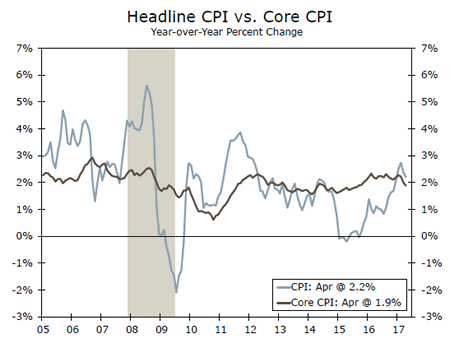
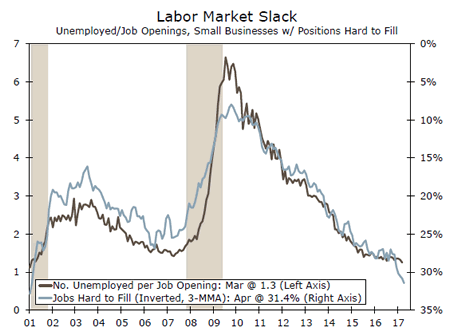
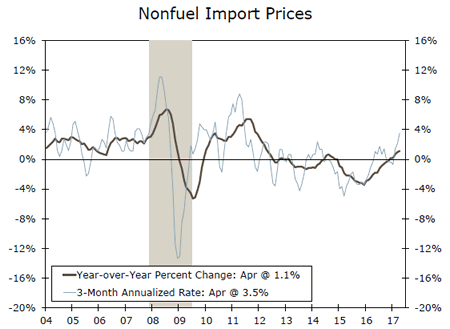
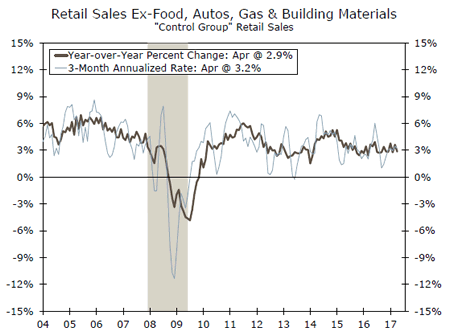
U.S. Outlook
Housing Starts • Tuesday
Unseasonably mild winter weather during the first two months of the year helped get homebuilding off to a strong start in 2017. The relatively favorable building conditions allowed more construction activity to begin earlier this year, with housing starts through the first three months of the year up 8.1 percent from a year ago. Apartment construction accounted for a significant portion of the increase, as starts of five units or more are up 14.1 percent on a year-to-date basis. Single-family housing starts are up a more modest 5.9 percent over the same period.
We look for housing starts to recoup most of March’s decline and rise to a 1.257 million-unit annual rate in April. While the mild winter weather likely pulled some building activity forward into the first quarter, we continue to expect housing starts to rise 7.3 percent this year, with virtually all of the growth coming from single-family construction.
Previous: 1,215K Wells Fargo: 1,257K Consensus: 1,260K

Industrial Production • Tuesday
Industrial production rose 0.5 percent in March, marking the second-largest increase in more than a year. However, the gain was almost entirely driven by a surge in utilities output, which reflected the return of more normal temperatures in March. Looking past the headline, manufacturing production declined 0.4 percent on the month, snapping a six-month string of gains. Notably, motor vehicle & parts output declined 3.0 percent as auto production pulled back. The weakness was not solely in autos, as declines were recorded across most durable and nondurable subsectors.
While the ISM manufacturing index edged another leg down April, the index remains at a still solid level that is consistent with our forecast. Looking to April, we expect a modest pickup in industrial production. While a breakout in activity seems unlikely in the nearterm, we expect manufacturing output expanded somewhat in April, and we look for a gain of 0.4 percent.
Previous: 0.5% Wells Fargo: 0.4% Consensus: 0.4%
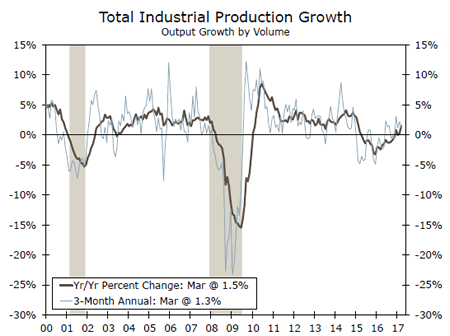
Leading Economic Index • Thursday
The Leading Economic Index (LEI) continued to trend higher in March, increasing 0.4 percent. The gain marks the index’s seventh-consecutive monthly increase. The improvement was relatively broad based as six of the LEI’s eight components added to growth over the month. The interest rate spread component was the largest contributor in March, adding 0.19 percentage points to the headline. ISM new orders and the housing permits components were also strong on the month. Meanwhile, manufacturing hours worked and initial jobless claims were sources of weakness, subtracting 0.13 percentage points and 0.09 percentage points from the topline figure.
We expect the LEI to rise a modest 0.4 percent in April. The yield spread, manufacturing average weekly hours and initial unemployment claims components likely provided the largest contributions to the index’s gain.
Previous: 0.4% Wells Fargo: 0.4% Consensus: 0.3%
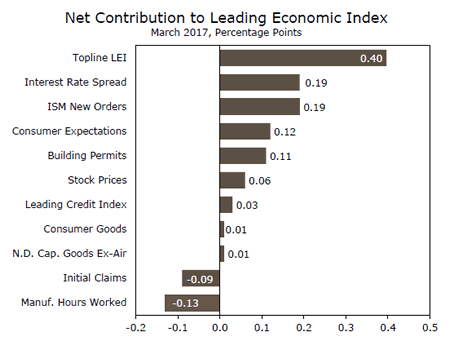
Global Review
French Elections, Canadian Housing, and More
- By early this week financial markets were breathing a big sigh of relief with the results from the French elections, which produced a lopsided victory for the establishment (for lack of a better term) candidate, Emmanuel Macron, versus the extreme right candidate, Marine Le Pen.
- Canadian housing starts came down as expected to a still relatively strong 214,100 unit pace from a slightly downwardly revised 252,300 unit pace in March. March’s increase in housing starts was the strongest print since early in 2012.
- Mexican industrial production remained flat in March.
Liberty, Equality, Fraternity
By early this week financial markets were breathing a big sigh of relief with the results from the French elections, which produced a lopsided victory for the establishment (for lack of a better term) candidate, Emmanuel Macron, versus the far right candidate, Marine Le Pen. Although polls before the election showed an almost uncontested election with Mr. Macron wining the contest almost unchallenged, many were concerned with the ability of polls to measure correctly, especially after several "surprises" during the last several years, i.e., Brexit and Trump.
Now, Mr. Macron will have to come up with a sound strategy to gain enough members in parliament during the June parliamentary elections as well as design a strategy to bring other parties to the table so he can form a governing coalition that can start delivering on his promises. And this is not going to be easy. Ms. Le Pen’s rallying banners are not something that you can dismiss and if the political system tries to do so they do it at their own perils. Although Ms. Le Pen lost the election, the gain in votes was very important. In fact, voter participation during this presidential election was one of the lowest since the 1981. Interestingly enough, Ms. Le Pen almost doubled the number of voters compared to her father’s, 10.6 million compared to 5.5 million in 2002, while Mr. Macron had only 20.7 million people voting for him versus 25.5 million who voted for Jacques Chirac in 2002 (read more on France’s challenges on our Topic of the Week section).
Canadian Housing Starts Payback in April
In Canada, the country’s housing market which has remained relatively strong, even as the economy downshifted due to the decline in oil prices over the last several years, saw some payback in April from the strong increase recorded in March. Housing starts came down as expected to a still relatively strong 214,100 unit pace from a slightly downwardly revised 252,300 unit pace in March. March’s increase in housing starts was the strongest print since early in 2012. Housing starts in Canada are normally volatile but it seems that volatility has increased considerably since 2015 (middle graph). Meanwhile, building permits were down further in March, this time 5.8 percent compared to a decline of 2.8 percent in February while the new housing price index was up 0.2 percent after increasing 0.4 percent in February. This follows a downgrade on Canadian banks by Moody’s investor services due to high household debt and concerns on high home prices.
Mexican Industrial Production Remains Flat in March
In Mexico, industrial production remained flat in March. Public utilities were up 0.5 while the mining sector improved 0.1 percent. However, manufacturing output was down 0.3 percent and construction output was down 0.2 percent. The year-over-year non-seasonally adjusted numbers looked much better, but those are not a good measure this time around because Easter occurred in March during 2016 and in April this year, which distorts the index and shows a stronger industrial sector than what it truly is.
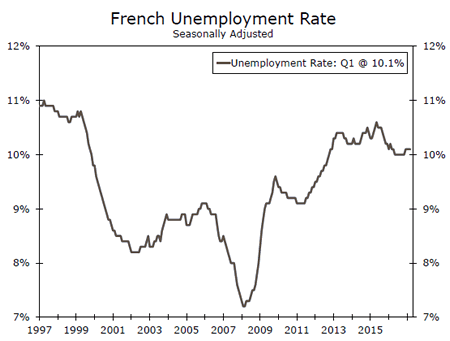
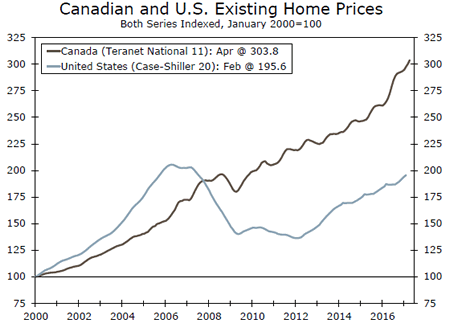
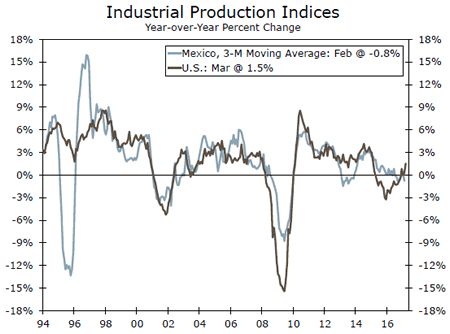
Global Outlook
U.K. CPI • Tuesday
The U.K. will release CPI inflation for April this coming Tuesday. The consensus forecast looks for it to rise 0.4 percent on the month and 2.6 percent year over year. The CPI inflation rate in the U.K. stands at 2.3 percent and has trended upwards since early 2016. The sharp depreciation of the British pound following the Brexit referendum last June has seemed to have inflation implications.
While the rebound in energy prices has certainly helped support price pressures, core CPI, which strips out energy effects, has picked up too. April’s core rate is expected to grow 2.2 percent in April, following 1.8 percent growth in March. The jump in prices has eroded growth in real income, which has, in turn, weighed on consumer spending. However, stagnation in average hourly earnings growth suggests that the core rate of inflation likely will not continue to shoot up.
Previous: 2.3% (Year-over-Year) Wells Fargo: 2.8% Consensus: 2.6%
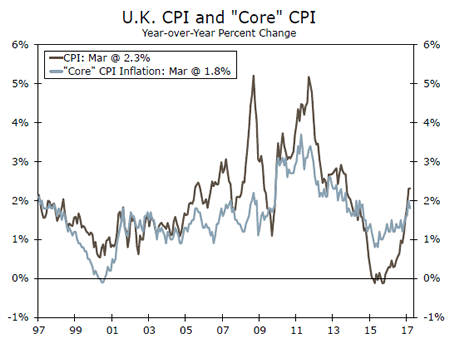
Japan Q1 GDP • Wednesday
Japanese economic growth in Q1 is slated for release on Wednesday of next week. GDP is expected to expand 0.4 percent on a sequential rate and 1.8 percent at an annualized rate. This would be an improvement from the 0.3 percent quarter-over-quarter rate and 1.2 percent annualized rate in Q4 2016. Economic growth appears to be strengthening to begin 2017 as a result of a relatively weak yen and strong global demand, which help the Japan’s vital export sector. Exports in March rose 12.0 percent, the fasted pace in over two years, coming at the heels of 11.3 percent growth in February.
Japan’s Tankan index for large manufacturers in Q1 jumped to its highest level since Q4 2015. Moreover, the Bank of Japan’s accommodative monetary policy seems to be supporting economic activity. We expect the Japanese economy to expand 1.2 percent in 2017, in-line with the consensus expectation.
Previous: 1.2% (Annualized) Wells Fargo: 2.3% Consensus: 1.8%
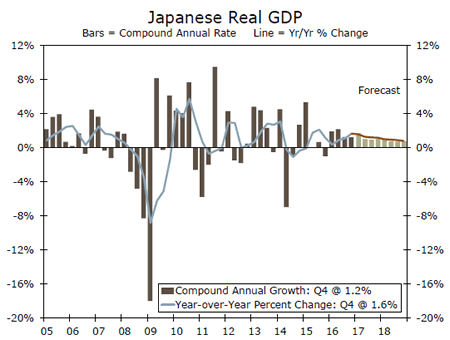
Canada CPI • Friday
Canadian CPI inflation for April is set to be released next Friday. Inflation cooled to 1.6 percent in March from 2.0 percent in February, year over year. March’s rate landed below the midpoint of the Bank of Canada’s (BoC) target range of 1 percent to 3 percent. On a sequential basis, prices actually declined 0.2 percent in March from a month earlier – a slight moderation from February’s 0.3 percent slide. Canada’s economy has been gaining momentum to begin 2017, helped by a rebounding energy sector that is enjoying higher oil prices. This, in turn, should put upward pressure on prices. We expect CPI inflation to average 2.3 percent in 2017 and 1.9 percent in 2018.
The BoC held its target rate for the overnight rate steady at 0.5 percent, expressing guarded optimism in its statement. In its April monetary report, the BoC revised its inflation expectations upward to 1.9 percent in 2017 and 2.0 percent in 2018.
Previous: 1.6% (Year-over-Year) Wells Fargo: 1.3% Consensus: 1.8%

Point of View
Interest Rate Watch
Elections and Market Economics.
Elections impact market expectations and certainly have altered prices thereby creating a political premium to markets independent of economic fundamentals. The challenge for investors is that political actions do alter market prices independent of any economic actions such that the fundamental values are obscured—at least for a short time.
Over the last year there have been interesting moves in the benchmark bond rates (top graph) and the euro/dollar spot rate (middle graph) that reflect expectations and the interaction of financial markets on a global scale.
Benchmark Bonds: A Political Barometer
In the top graph, the pattern of ten-year yields corroborates the politics/market pricing interaction. With the election of Donald Trump, the ten-year US-German and US-French spread widened out as expectations for economic policy actions and thereby more rapid economic growth took center stage. However, since the inauguration yield differences have declined as the realization that policy initiatives will take time and are likely to be moderated in scale as the legislative process moves forward. Tax cuts and fiscal stimulus through infrastructure spending will take time. Reflect on the observations that President Reagan’s tax program did not pass Congress until August of his first year. The anticipation of the FOMC’s increase in the funds rate in March provided a short-term boost to the benchmark rate but did not alter the broader downtrend to a level just above the pre-election level.
Euro/Dollar Spot and Economic Expectations: Caught in the Political Vortex
As illustrated in the middle graph, the euro/dollar exchange rate also exhibited a sharp reaction, in the short run, to the election and anticipation of economic change. Moreover, like benchmark yields, the exchange rate has drifted back toward pre-election levels. Finally, the U.S. PMI index has moved up and now back down as policy expectations have adjusted.

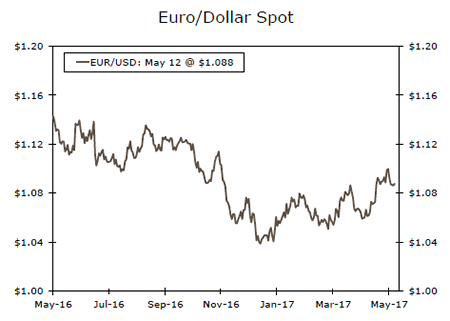

Credit Market Insights
Positive Attitudes Toward Housing
Earlier this week, the Federal Reserve Bank of New York released the results of its 2017 SCE Housing Survey which sheds light on consumers’ expectations, behaviors and experiences related to home buying. The survey showed that more home buyers are expecting home prices to increase on a oneand five-year outlook. Moreover, a growing share of households still views owning a home as a sound financial investment.
That said, consumers’ expectations for an increase in future mortgage rates have also increased, rising to 5.6 percent from 5.2 percent in 2016. Furthermore, sixty-five percent of renters still view obtaining a mortgage as difficult, but thought credit access was becoming easier. That said, tightening credit standards and rising mortgage rates (though still low) could make it more difficult and expensive for some to purchase a home.
What is encouraging is that renters are optimistic about their home buying prospects with 55.2 percent of those surveyed indicating that they will own a home at some point in the future. In fact, first quarter data for household formations showed the share homeowners rising to its highest level since Q3-2006, signaling that an increasing number of households are choosing home owning over renting.
With attitudes toward home buying remaining positive and more renters looking to own, we expect housing starts to reach 1.26 million units in 2017 and 1.35 million in 2018.
Topic of the Week
Emmanuel in Élysée
On May 7th the people of France elected 39 year old Emmanuel Macron as the leader of France, decisively defeating far-right leader Marine Le Pen (top chart). Having never held elected office, questions have risen over whether he can live up to his lofty campaign promises, which include significant economic reform. In his acceptance speech, Macron acknowledged the divisions and doubts disturbing France, but made a pledge to defend all peoples of France and Europe, making note of the common destiny of the European continent. Macron’s staunchly pro-Europe stance stands in direct contrast to the rhetoric of his opponent.
Macron’s pro-market agenda includes cutting regulation and improving education to boost competitiveness. Macron wants to cut 120,000 public sector jobs and take further measures to stabilize public finances. Moreover, reducing the unemployment rate to seven percent, from its current 10.1 percent level, is an objective of his administration. Other potential reforms include reducing the corporate tax rate to 25 percent from its current 33.3 percent rate. A 50-billion-euro investment program targeting specific industries such as renewable energy and transportation was also floated on the campaign trail. However, his reformist agenda could be undermined if he is unable to secure a favorable result in the parliamentary elections in June. Picking up seats in these elections should aid his legislative goals.
Macron is inheriting a French economy that is failing to gain traction and one that does not seem likely to break out any time soon. French GDP expanded just 1.2 percent in 2016 and has averaged just 0.8 percent on an annual rate over the past 5 years. Recently released GDP data for Q1 suggest the economy also started off 2017 on weak footing. GDP growth was just 0.3 percent on a sequential basis, and was just 0.8 percent, year over year (bottom chart). Macron’s economic goals will likely be challenged by the weak French economy. However, consumer sentiment in France is rising, a signal that Macron has the people of France’s confidence.
